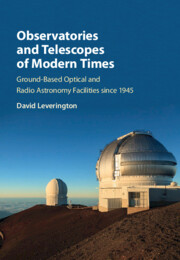 Observatories and Telescopes of Modern Times
Observatories and Telescopes of Modern Times from Part 1 - Optical Observatories
Published online by Cambridge University Press: 15 December 2016
Spun Honeycomb Mirrors
The second half of the twentieth century saw the development of three different designs of primary mirror for large optical reflectors. These were spun honeycomb mirrors as used in the Vatican Advanced Technology Telescope on Mount Graham, segmented mirrors (see Section 4.2) as used in the Keck Telescope on Mauna Kea, and thin meniscus mirrors (see Section 4.3) of the sort used in ESO's New Technology Telescope on La Silla. A fourth type, a liquid mirror (see Section 4.5), was also developed, but this had more limited applications. This present section outlines the development of spun honeycomb mirrors as produced at the University of Arizona's Steward Observatory Mirror Laboratory.
The Multiple Mirror Telescope (MMT) had been completed at the Whipple Observatory on Mount Hopkins, Arizona in 1979 with six 72 inch (1.8 m) honeycomb mirrors. These mirrors, made of low expansion, fused silica glass, had been obtained as Air Force surplus equipment. The design of this MMT (see Chapter 10) was innovative in many ways. For example, the observatory building had been designed to allow rapid air movement across both the mirror and telescope structure, allowing them to achieve ambient temperatures quickly and stay there. The honeycomb structure of the mirrors also assisted this.
Neville Woolf of the University of Arizona suggested to his colleague Roger Angel that he look into the possibility of building a larger telescope than the MMT of the same general design.(1) Angel was impressed by the performance of the MMT's honeycomb mirrors and decided to look into the possibility of building larger ones without using expensive low-expansion glass. Instead, Angel and his graduate student John Hill decided to use borosilicate glass, as not only was it cheaper but it had a much lower melting temperature than the low-expansion alternatives, making it easier to cast.
Honeycomb backing for mirrors had been around for some time. The design, which was then called cellar or ribbed, had first been suggested by George Ritchey in the 1920s,(2) and had been used in a modified form for the 200 inch (5 m) Palomar Telescope that saw first light in the late 1940s.
To save this book to your Kindle, first ensure [email protected] is added to your Approved Personal Document E-mail List under your Personal Document Settings on the Manage Your Content and Devices page of your Amazon account. Then enter the ‘name’ part of your Kindle email address below. Find out more about saving to your Kindle.
Note you can select to save to either the @free.kindle.com or @kindle.com variations. ‘@free.kindle.com’ emails are free but can only be saved to your device when it is connected to wi-fi. ‘@kindle.com’ emails can be delivered even when you are not connected to wi-fi, but note that service fees apply.
Find out more about the Kindle Personal Document Service.
To save content items to your account, please confirm that you agree to abide by our usage policies. If this is the first time you use this feature, you will be asked to authorise Cambridge Core to connect with your account. Find out more about saving content to Dropbox.
To save content items to your account, please confirm that you agree to abide by our usage policies. If this is the first time you use this feature, you will be asked to authorise Cambridge Core to connect with your account. Find out more about saving content to Google Drive.